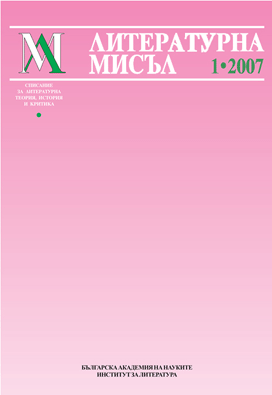За калпака и фрака. Размисли върху културната символика на пре/обличането в „Бай Ганьо”
On the Sheepskin Cap and the Tailcoat:
Thoughts on the Cultural Symbolism of the (Changing of) Clothes in “Bay Ganyu”
Author(s): Kalina GalunovaSubject(s): Literary Texts
Published by: Институт за литература - БАН
Keywords: 19th century's Bulgarian reality; European civilization; cultural symbolism of the changing of clothes; Bulgarian literary character Bay Ganyu
Summary/Abstract: The present article deals with the sign connotations of the separate elements of the well-known Bulgarian literary character Bay Ganyu’s outer portrait. Examined here is the functioning of those elements in the Bulgarian cultural milieu, separate from the author’s intentions to profane them by projecting them against the background of European civilization. The text also reflects on the cultural symbolism of the changing of clothes and more exactly on the Bulgarian ‘disguising’ in Bay Ganyu’s time. Interpreted through the code meaning of his portrait’s separate elements and through the way they function in the Bulgarian folk consciousness, Bay Ganyu stands out as a new incarnation of the folklore ‘madcap’, and shows close similarity to the stereotyped image of the folklore hero – outlaw/rebel/revolutionary etc. ‘hot head’ and fighter on the frontier of the national. But, by dressing in homespun clothes and sheepskin cap, Bay Ganyu in fact does not deny the contact with the foreign civilization – the tailcoat finds a way to his broad-shouldered figure, although not without some kind of resistance. He does not perceive ‘Europeanization’ as ‘disguising’, as a change of form and identity. The grotesque combination of the sheepskin cap and the tail coat is actually an endeavour to draw together the two cultures, an attempt at mutual recognition and respect, at combination and gradual assimilation – a mission which proved to be historically impossible in the late 19th century’s Bulgarian reality. Thus, Bay Ganyu is a symbol of the other possibility, of the turned down alternative, which will come to life again and again whenever Bulgaria crashes on its way to Europe.
Journal: Литературна мисъл
- Issue Year: 2007
- Issue No: 1
- Page Range: 133-149
- Page Count: 17
- Language: Bulgarian
- Content File-PDF

